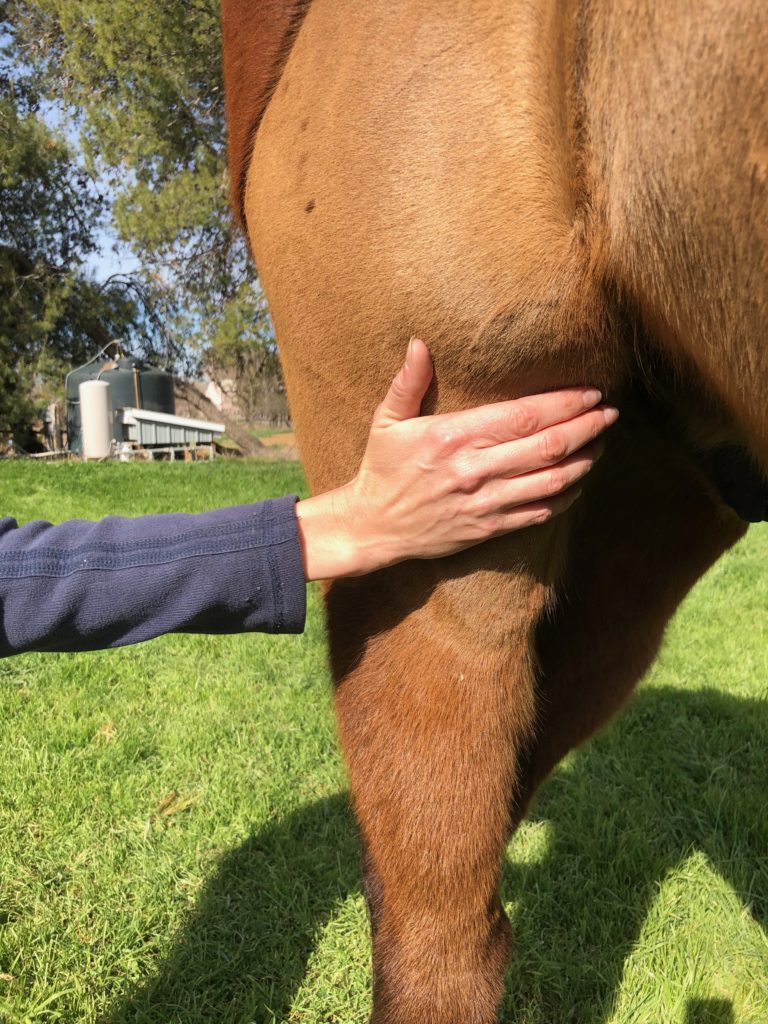WEAK STIFLE MUSCLES IN HORSES: PART 1: SIGNS, SYMPTOMS AND SOLUTIONS – BY ANN RAMSEY, BS, CERA, APF-I
Poor stifle function is common in working horses and usually goes unnoticed by trainers, owners and vets alike. Why? Because the signs can be vague and a small glitch in stifle function can be hard to see unless you look for it. Stifle weakness can slide past even seasoned diagnosticians; when looking for sources of pain in the hind limb, there are three joints that reciprocally flex together: the feltlock, hock and stifle. Prolonged pain in the hind limb can stress the sacroilliac joint as well, adding yet another layer.
Sorting out which joint is the source of pain can take time, and Veterinary diagnostics. But it is well worth it, as this common stifle dysfunction is highly treatable if caught early. Not only are the outcomes frequently good, owners can dispense the rehabilitation themselves usually without medications. While the early signs are subtle, almost anyone can learn to spot them and bring them to attention of their vet.
The stifle (the horse’s true knee), has a patella just like ours. But there is a special system called the stay apparatus that allows horses to lock this joint while sleeping. The dysfunction occurs when the muscles that surround and support this sensitive system become weak. When the muscles do not have adequate tension and coordination, the medial patellar ligament becomes momentarily strummed on the trochlear ridge of the femur. This is painful and causes the horse to brace the limb, and lumbar spine. Over time the horse may develop arthritis or damage to the patellar ligaments, which could be career ending. So thoroughly checking and monitoring the stifle is key.
SIGNS AND SYMPTOMS
Mild to acute lameness in the hind limb would be the most obvious symptom, but by the time this is present joint dysfunction has been ongoing for some time. If the horse is severely lame, the weakness may have progressed into a full-blown disease known as Upward Fixation of the Patella. This occurs when the entire pelvic limb becomes locked due to muscle weakness and joint instability. The subtle signs of simple muscle weakness, show up much sooner. This is the ideal stage to arrest the problem for the best outcome.
Simple muscle weakness is usually bilateral so the horse in pain may shorten the stride of both hind limbs disguising any obvious limp. To compensate for stifle pain, horses will often change the flight pattern of the entire limb. If you view them walking away, they tend to move the whole limb in a circular pattern called circumduction. This is to avoid bending and flexing the joint, as full range of motion of the stifle may cause the catching effect which is painful.

Horses in work will stumble in downward transitions, especially canter to trot. They may pin their ears and move hollow for a few strides while moving and then return to normal. Jumping may become very difficult and bucking upon landing can occur. This is often because the whole hind limb and all the reciprocal joints as well as the SI are impacted by the problem. Sacroilliac pain is commonly concurrent.
Horses will frequently have muscle spasms and pain in the long back muscles as the lumbar spine is overtaxed from frequent bracing. These additional compensations have to be addressed and treated along with the stifle weakness for a full recovery.






